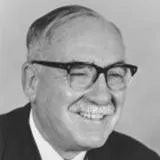
Professor Henry Barcroft (1904 - 1998)
Biography
A physiologist who wasn’t afraid to get his feet wet
Henry Barcroft was Professor of Physiology at St Thomas’ Hospital from 1948 to his retirement. He was a scientist who stimulated research in medicine, with a particular interest in peripheral circulation.
Early in his career, he developed a new form of the stromuhr, an instrument which measures the rate of blood flow, and during the Second World War he studied the physiological effects of haemorrhage.
Barcroft famously tested the effect of mechanical contraction of blood vessels on local blood flow by using himself as a subject. With colleagues, he stood for hours in bins filled with water at core body temperature. His experiments showed that sustained muscle contraction at 20-30 per cent maximal strength almost completely arrested blood flow in the calf of the subject, whereas rhythmic contractions, such as those caused by walking, increased blood flow.
Sympathetic Control of Human Blood Vessels, which Barcroft wrote with H.J.C. Swan, was the first monograph published by the Physiological Society, in 1953. One reviewer described it as being written in ‘simple and direct language, and illustrated by the elegantly clear diagrams that characterise all Barcroft's papers’, concluding: ‘It has stood the test of time.’
